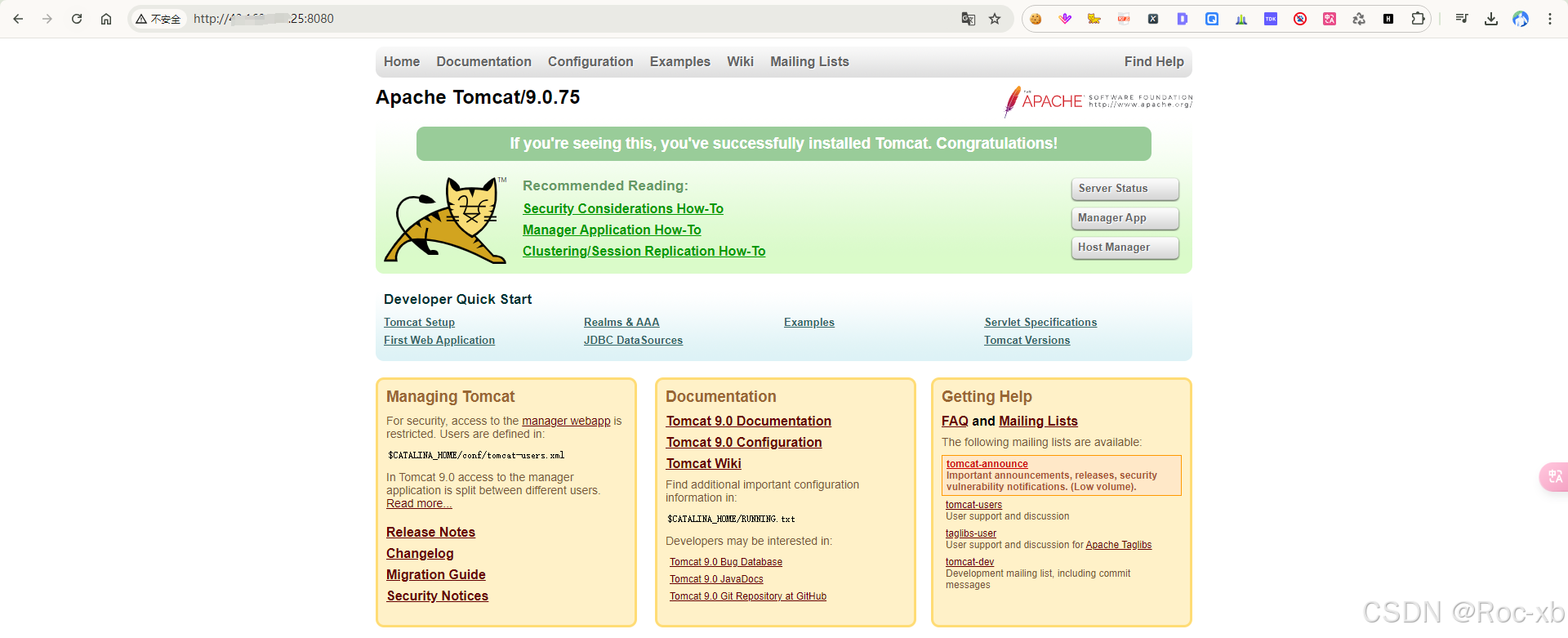小阿轩yx-Prometheus监控系统部署
前言
- Prometheus 由 Go 语言编写而成,采用 Pull 方式获取监控信息,并提供了多维度的数据模型和灵活的査询接口。
- Prometheus 不仅可以通过静态文件配置监控对象,还文持自动发现机制,能通过 Kubernetes、Consl、DNS 等多种方式动态获取监控对象。
- 在数据采集方面,借助 Go 语言的高并发特性,单机 Prometheus 可以采取数百个节点的监控数据;
- 在数据存储方面,随着本地时序数据库的不断优化,单机 Prometheus 每秒可以采集一千万个指标,如果需要存储大量的历史监控数据,则还支持远程存储。
Prometheus 的架构介绍
起源
- Prometheus 起源于 Soundcloud ,因为微服务迅速发展,导致实例数量以几何倍数递增,不得不考虑设计一个符合以下几个功能的监控系统
- 多维数据模型,可以按照实例,服务,端点和方法之类的维度随意对数据进行切片和切块。
- 操作简单,可以随时随地部署监控服务,甚至在本地工作站上,而无需设置分布式存储后端或重新配置环境。
- 可扩展的数据收集和分散的架构,以便于可以可靠的监控服务的许多实例,独立团队可以部署独立的监控服务。
- 转化为一种查询语言,可以利用数据模型进行有效的警报和图形展示。
但是,当时的情况是,以上的功能都分散在各个系统之中
直到 2012年 Soundcloud 某位大神启动了一个孵化项目,Soundcloud 才把所有功能集合到一起,这时也就有了 Prometheus。
- Prometheus 是用 Go 语言编写,从一开始就是开源的。
- 2016年 Prometheus 成为继 Kubernetes 之后,成为 CNCF(Cloud Native computing Foundation)第二个成员。
什么是 Prometheus
- Prometheus 具有足够的通用性
可以监控各个级别的实例
- 自己的应用程序
- 第三方服务
- 主机或网络设备
此外 Prometheus 特别适用于监控动态云环境和 Kubernetes 云原生环境。
但是要注意 Prometheus 并不是万能的,目前并没有解决下面的一些问题
- 日志和追踪(Prometheus 只处理指标,也称为时间序列)
- 基于机器学习或 AI 的异常检测
- 水平扩展、集群化的存储
Prometheus 的运行原理
- 通过 Http 协议周期性抓取被监控组件的状态。
- 输出被监控组件信息的 Http 接口称为 exporter。
- 常用组件大部分都有 exporter 可以直接使用
- 比如 haproxy,Nginx,MSOL,Linux 系统信息(磁盘、内存、CPU、网络等)
Prometheus 组件构成
- Prometheus 生态系统由多个组件构成,架构图

Prometheus server
- 服务核心组件,采用 pull 方式收集数据,通过 http 协议传输。并存储时间序列数据
Exporters/Jobs
- 负责收集不支持 Instrumentation 的目标对象的性能数据,并通过 HTTP 接口供 PrometheusServer 获取。
Node-Exporter
- 用于收集各 node 节点的物理指标状态数据,如平均负载、CPU、内存、磁盘、网络等资源信息的指标数据,需要部署到所有运算节点。
Kube-State-Metrics
- 为 prometheus 采集 k8s 资源数据的 exporter,通过监听 APIServer 收集 kubernetes 集群内资源对象的状态指标数据
- 同时它也提供自己的数据,主要是资源采集个数和采集发生的异常次数统计。
- 需要注意 kube-state-metrics 只是简单的提供一个metrics 数据,并不会存储这些指标数据,所以可以使用 Prometheus 来抓取这些数据然后存储,主要关注的是业务相关的一些元数据
- 比如 Deployment、Pod、副本状态等
cadvisor
- 用来监控容器内部使用资源的信息,比如CPU、内存、网络 I/0、磁盘 I/O。
blackbox-exporter
- 监控业务容器存活性。
Service Discovery
- 服务发现,Prometheus 支持多种服务发现机制
- 文件
- DNS
- Consul
- Kubernetes
- OpenstackEC2
- 基于服务发现的过程并不复杂,通过第三方提供的接口,Prometheus 查询到需要监控的 Target 列表,然后轮循这些 Target 获取监控数据。
Alertmanager
- 是一个独立的告警模块,从 Prometheus server 端接收到 alerts 后,会进行去重、分组, 并路由到相应的接收方,发出报警
常见的接收方式有
- 电子邮件
- 微信
- 钉钉
Pushgateway
- 类似一个中转站,Prometheus 的 server 端只会使用 pull 方式拉取数据,但是某些节点因为某些原因只能使用 push 方式推送数据,那么它就是用来接收 push 而来的数据并暴露给 Prometheus 的server 拉取的中转站。
- 可以理解成目标主机可以上报短期任务的数据到 Pushgateway,然后 Prometheus server 统一从Pushgateway 拉取数据
Grafana
- 是一个跨平台的开源的度量分析和可视化工具,可以将采集的数据可视化的展示,并及时通知给告警接收方。
- 官方库中具有丰富的仪表盘插件。
Prometheus 的特性
提供多维度数据模型和灵活的查询语言
- 通过将监控指标关联多个Tag,来将监控数据进行任意维度的组合;
- 提供 HTTP 查询接口;
- 可以很方便的结合Grafana等组件展示数据。
支持服务器节点的本地存储
- 通过 prometheus 自带的时序数据库,可以完成每秒千万级的数据存储。
- 不仅如此,在保存大量历史数据的场景中,prometheus 还可以对接第三方时序数据库
- 如 OpenTSDB 等。
定义了开放指标数据标准
- 以基于 HTTP 的 Pull 方式采集时序数据,只有实现了 prometheus 监控数据格式的监控数据才可以被 prometheus 采集;
- 并支持以 Push 方式向中间网关推送时序数据,能更灵活地应对各种监控场景。
支持通过静态文件配置和动态发现机制发现监控对象
- 自动完成数据采集。
- prometheus 目前已经文持 Kubernetes、consul 等多种服务发现机制,可以减少运维人员的手动配置环节。
支持多种多样的图表和界面展示
- 比如 Grafana 等。
Prometheus 的工作流程

- 配置监控目标:在 Prometheus 配置文件中定义监控目标及其相应的指标。
- 拉取指标数据:Prometheus 会定期从监控目标拉取指标数据,并将数据存储到本地存储中。
- 存储指标数据:Prometheus 会使用一种自定义的时间序列数据库(TSDB)存储指标数据,以便进行分析和查询。
- 分析指标数据:Prometheus 提供了一个表达式语言,可以基于时间序列数据进行数据处理和分析操作,比如计算归一化指标、统计分位数、处理异常值等。
- 查询指标数据:Prometheus 提供了一个基于 HTTP 的査询 API,可以用来执行査询操作和获取查询结果,获取到的查询数据可以通过图表和仪表盘的方式进行展示。
Grafana 介绍
- 是一款用 Go 语言开发的开源数据可视化工具
- 可以做数据监控和说几句统计,带有告警功能
特点
可视化
- 快速和灵活的客户端图形具有多种选项,面板插件为许多不同的方式可视化指标和日志。
报警
- 可视化地为最重要的指标定义警报规则,Granfana 将持续评估他们,并发送通知。
通知
- 警报更改状态时,他会发出通知,接受电子邮件通知。
动态仪表盘
- 使用模板变量创建动态和可重用的仪表盘,这些模板变量作为下拉菜单出现在仪表板顶部。
混合数据源
- 在同一个图中混合不同的数据源,可以根据每个查询指定数据源,这甚至适用于自定义数据源。
注释
- 注释来自不同数据源图标,将鼠标悬停在事件上可以显示完整的事件元数据和标记。
过滤器
- 过滤器允许您动态创建新的键~值,这些过滤器将自动应用于该数据源的所有查询。
Prometheus 的安装
资源配置
| IP | 节点 | 组件 |
| 192.168.10.108 | Prometheus 服务器 | Prometheus、Node_exporter |
| 192.168.10.107 | Grafana 服务器 | Grafana |
| 192.168.10.101 | Agent01 服务器(Linux 主机) | Ndoe_exporter |
| 192.168.10.102 | Agent02 服务器(Linux 主机) | Ndoe_exporter |
| 192.168.10.103 | Agent03 服务器(windows 主机) | windows_exporter |
部署 Prometheus
Prometheus 的安装包可以前往官网下载
https://prometheus.io/download/
将 Prometheus 的源码包上传至主机 108

修改主机名称
[root@localhost ~]# hostnamectl set-hostname prometheus
[root@localhost ~]# bash关闭防火墙、内核机制
[root@prometheus ~]# systemctl stop firewalld
[root@prometheus ~]# systemctl disable firewalld
[root@prometheus ~]# setenforce 0
[root@prometheus ~]# vim /etc/sysconfig/selinux
##修改为
SELINUX=disabled解压
[root@prometheus ~]# tar zxvf prometheus-2.48.0.linux-amd64.tar.gz移动到指定目录下
[root@prometheus ~]# mv prometheus-2.48.0.linux-amd64 /usr/local/prometheus链接到指定目录下
[root@prometheus ~]# In -s /usr/local/prometheus/prometheus /usr/local/bin
[root@prometheus ~]# In -s /usr/local/prometheus/promtool /usr/local/bin查看版本
[root@prometheus ~]# prometheus --version
prometheus, version 2.48.0 (branch: HEAD, revision:
6d80b30990bc297d95b5c844e118c4011fad8054)
build user: root@26117804242c
build date: 20231116-04:35:21
go version: go1.21.4
platform: linux/amd64
tags: netgo,builtinassets,stringlabels注册 Prometheus 的系统服务
[root@prometheus ~]# vim /usr/lib/systemd/system/prometheus.service
[Unit]
Description=https://prometheus.io
[Service]
Restart=on-failure
ExecStart=/usr/local/prometheus/prometheus
--config.file=/usr/local/prometheus/prometheus.yml --web.listen-address=:9090
[Install]
WantedBy=multi-user.target启动服务
[root@prometheus ~]# systemctl daemon-reload
[root@prometheus ~]# systemctl enable --now prometheus访问测试
访问 Prometheus 首页
- http://192.168.10.108:9090/

查看被监控端的状态
- 点击 stats-Targets

查看详细监控信息
- http://192.168.10.108:9090/metrics

部署 node_exporter
- Exporter 是 Prometheus 的指标数据收集组件。
- 它负责从目标 Jobs 收集数据,并把收集到的数据转换为 Prometheus 支持的时序数据格式。
和传统的指标数据收集组件不同的是
- 它只负责收集,并不向 Server 端发送数据,而是等待 Prometheus Server 主动抓取
node-exporter 默认的抓取 url 地址
- http://ip:9100/metrics
agent 服务器端(被监控端)安装 node_exporter
将 node_exporter 源码包上传至 101、102

修改主机名称
主机一
[root@localhost ~]# hostnamectl set-hostname agent01
[root@localhost ~]# bash主机二
[root@localhost ~]# hostnamectl set-hostname agent02
[root@localhost ~]# bash101和102开启会话同步
[root@agent01 ~]# systemctl stop firewalld
[root@agent01 ~]# systemctl disable firewalld
[root@agent01 ~]# setenforce 0
[root@agent01 ~]# vim /etc/sysconfig/selinux
##修改为
SELINUX=disabled解压
[root@agent01 ~]# tar zxvf node_exporter-1.7.0.linux-amd64.tar.gz移动文件到指定目录下
[root@agent01 ~]# mv node exporter-1.7.0.linux-amd64 /usr/local/node_exporter添加服务为系统服务
[root@agent01 ~]# vim /usr/lib/systemd/system/node exporter.service
[Unit]
Description=node_exporter
After=network.target
[Service]
ExecStart=/usr/local/node_exporter/node_exporter
Restart=on-failure
[Install]
WantedBy=multi-user.target启动服务
[root@agent01 ~]# systemctl daemon-reload
[root@agent01 ~]# systemctl start node_exporter
[root@agent01 ~]# systemctl enable node_exporter查看端口
[root@agent01 ~]# netstat -anpt | grep 9100
tcp6 0 0 :::9100 :::* LISTEN 6352/node_exporter- windows 主机的 exporter 程序监听的 9182 端口
取消会话同步
在 windows 系统安装 exporter
打开一个 windows 系统(以 win10 系统演示)
将所需的程序包复制或上传至 win10 系统

只需鼠标双击运行就OK
最后在控制面板找到防火墙并关闭

在 Prometheus 服务端配置文件添加监控项
进入 Prometheus 配置文件添加 target(108主机)
[root@prometheus ~]# vim /usr/local/prometheus/prometheus.yml
#进入 Prometheus 安装目录下修改主配置文件
- job_name: "prometheus"
# metrics_path defaults to '/metrics'
# scheme defaults to 'http'.
static_configs:
- targets: ["192.168.200.100:9090"]
- job_name: 'agent'
static_configs:
- targets: ['192.168.10.101:9100'.'192.168.10.102:9100','192.168.10.50:9182']- Linux 主机的 exporter 进程监听的是TCP 9100 端口。
- windows 主机的exporter 进程监听的TCP9182 端口。
重启 Prometheus 服务
[root@prometheus ~]# systemctl restart prometheus.service重启完浏览器刷新访问 192.168.10.108:9090,打开普罗米修斯的监控页面 status-Targets 查看
有没有添加成功。

Grafana 的部署与应用
部署 Grafana
(新开一个 107 主机)
将 grafana 的 rpm 上传至主机

修改主机名称
[root@localhost ~]# hostnamectl set-hostname grafana
[root@localhost ~]# bash安装 grafana
[root@grafana ~]# yum -y install grafana-enterprise-10.2.2-1.x86 64.rpm启动服务
[root@grafana ~]# systemctl start grafana-server
[root@grafana ~]# systemctl enable grafana-server查看状态
[root@grafana ~]# systemctl status grafana-server关闭防火墙、内核机制
[root@grafana ~]# systemctl stop firewalld
[root@grafana ~]# systemctl disable firewalld
[root@grafana ~]# setenforce 0
[root@grafana ~]# vim /etc/sysconfig/selinux
##修改为
SELINUX=disabled浏览器访问 Grafana
- http://192.168.10.107:3000/login
- 默认端口为:3000
登录
- 初始账号和密码都是 admin

设置数据源
- 第一次登录进入后让设置新的密码,进入 Grafana,点击 DATA SOURCRE 添加数据源。

设置 Prometheus 为数据源

填写连接信息

在页面底端点击保存并测试的按钮

查看添加的数据源
- 点击“connections” --> “Data sources”,查看已添加的数据源

用导入模板的方法添加 Grafana 监控面板
在 home 页面点击添加 dashboard

选择导入模板的方法

指定模板 ID
- 模板 ID 可以从 Grafana 官网获得,Grafana 为用户提供了大量的模板,简化了用户的管理难度。
本案例中使用的模板 ID 为 12633,填写好 ID 后点击 “Load” 按钮
- https://grafana.com/grafana/dashboards/
12633:针对 Linux 的节点进行监控的模板
14694:针对 windows 的节点进行监控的模板
用户也可以选择其他对应的模板进行创建

选择数据源
- 在下拉菜单中选择对应的数据源,再点击 “Import” 按钮进行导入。

导入后查看监控图像

自定义 dashboard 监控面板
在 home 页面点击添加 dashboard

选择 “Add visualization” 方式添加 dasboard
- visualization:可视化
- 此方法需要用户手动对 dashboard 面板进行布局,监控参数也需要用户自行设置。

选择 Prometheus 数据源

设置查询规则
- Metric:选择监控项
- Label filters:设置过滤规则,表示要监控哪台主机
- Instance:表示使用被监控主机的 IP 地址选择
- Job:表示使用主机名进行选择

Prometheus 告警
安装告警组件 alertmanager
将 alertmanager-0.26.0.linux 源码包上传至主机108

解压
[root@prometheus ~]# tar zxvf alertmanager-0.26.0.linux-amd64.tar.gz将文件移动到指定目录下
[root@prometheus ~]# mv alertmanager-0.26.0.linux-amd64 /usr/local/alertmanager添加 alertmanager 服务
[root@prometheus ~]# vim /usr/lib/systemd/system/alertmanager.service <<'EOF'
[Unit]
Description=alertmanager project
After=network.target
[Service]
Type=simple
ExecStart=/usr/local/alertmanager/alertmanager
--config.file=/usr/local/alertmanager/alertmanager.yml
--storage.path=/usr/local/alertmanager --web.listen-address=0.0.0.0:9093
Restart=on-failure
[Install]
WantedBy=multi-user.target启动服务
[root@prometheus ~]# systemctl daemon-reload
[root@prometheus ~]# systemctl start alertmanager
[root@prometheus ~]# systemctl enable alertmanager- 属性解析:web.listen-address 是与 prometheus 交互的端
访问 alertmanager 的 WEB 页面
- alertmanager 的 web 界面使用 9093 的端口
登录的 url
- http://192.168.10.108:9093

将 alertmanager 增加到 prometheus
[root@prometheus ~]# vim /usr/local/prometheus/prometheus.yml
#修改 targets 对应的地址为 Prometheus 的地址
alerting:
alertmanagers:
- static_configs:
- targets:
- 192.168.10.108:9093- - 192.168.10.108:9093
检查 Prometheus 配置文件的语法
[root@prometheus ~]# promtool check config /usr/local/prometheus/prometheus.yml
Checking /usr/local/prometheus/prometheus.yml
SUCCESS: 1 rule files found
SUCCESS: /usr/local/prometheus/prometheus.yml is valid prometheus config file syntax
Checking /usr/local/prometheus/rules/hoststats-alert.rules
SUCCESS: 3 rules found重启 Prometheus
[root@prometheus ~]# systemctl restart prometheus查看端口
[root@prometheus ~]# netstat -anpt | grep 9090
tcp6 0 0 :::9090 :::* LISTEN 13275/prometheus
tcp6 0 0 ::1:43604 ::1:9090 TIME_WAIT -添加邮箱告警媒介
[root@prometheus ~]# vim /usr/local/alertmanager/alertmanager.yml
global:
#当告警的状态由"firing"变为"resolve"的以后还要呆多长时间,才宣布告警解除
resolve_timeout: 5m
#qq邮箱 smtp 端口
smtp_smarthost: 'smtp.qq.com:25'
#发件人邮箱
smtp_from: '406720950@qq.com'
#邮箱地址
smtp_auth_username: '406720950@qq.com'
#邮箱安全码
smtp_auth_password: 'pcmibkzesjqqcaha'
smtp_hello: 'qq.com'
#不携带证书请求
smtp_require_tls: false
# 路由配置
route:
group_by: ['alertname', 'cluster']
group_wait: 10s
group_interval: 10s
repeat_interval: 10s
receiver: 'email'
# 收信人员
receivers:
- name: 'email'
email_configs:
- to: '406720950@qq.com'
send_resolved: true
# 规则主动失效措施,如果不想用的话可以取消掉
inhibit_rules:
- source_match:
severity: 'critical'
target_match:
severity: 'warning'
equal: ['alertname', 'dev', 'instance']- global:
- smtp_smarthost: 'smtp.qq.com:25'
- smtp_from: '406720950@qq.com'
- smtp_auth_username: '406720950@qq.com'
- smtp_auth_password: 'pcmibkzesjqqcaha'
- # 收信人员
- receivers:
- - to: '406720950@qq.com'
重启服务
[root@prometheus ~]# systemctl restart alertmanager查看状态
[root@prometheus ~]# netstat -tunlp | grep alert
tcp6 0 0 :::9093 :::* LISTEN 13222/alertmanager
tcp6 0 0 :::9094 :::* LISTEN 13222/alertmanager
tcp6 0 0 :::9094 :::* 13222/alertmanager- alertmanager 进程使用的是 TCP 9094 的端口。
配置 prometheus,添加告警规则
每个告警规则有五部分组成
- 名称(alert)
- 触发条件(expr),这是个 PromQL 表达式,例如 CPU 使用率超过 58%,在触发条件被满足之前,告警的状态都是 Inactive
- 持续时间(for),例如 CPU 使用率超过 58%的时间持续 30 秒,在 30 秒之内,此告警状态为 pending,超过 30 秒就进入 firing 状态
- 标签(labels),给告警打上标签,在使用时可以根据标签定位到指定告警
- 注解(annotations),对告警的描述,这些内容可以用来详明告警时刻的详细情况
向 Prometheus 中添加告警规则路径
[root@prometheus ~]# mkdir /usr/local/prometheus/rules修改配置文件
[root@prometheus ~]# vim /usr/local/prometheus/prometheus.yml
rule files:
- /usr/local/prometheus/rules/*.rules添加告警规则
[root@prometheus ~]# vim /usr/local/prometheus/rules/hoststats-alert.rules
groups:
- name: node1_alerts
rules:
- alert: HighNodeCpu
expr: instance:node_cpu:avg_rate1m > 10
for: 1m
labels:
severity: warning
annotations:
summary: Hgih Node CPU for 1 hour
console: This is a Test
- alert: HostOutOfMemory
expr: node_memory_MemAvailable_bytes / node_memory_MemTotal_bytes * 100 < 10
for: 2m
labels:
severity: warning
annotations:
summary: Host out of memory (instance {{ $labels.instance }})
description: "Node memory is filling up (< 10% left)\n VALUE = {{ $value }}\n LABELS = {{ $labels }}"
- alert: InstanceDown
expr: up == 0
for: 10s
labels:
severity: critical
annotations:
summary: Host {{ $labels.instance }} of {{ $labels.job }} is Down!该规则文件总共添加了三条规则
- 第一个规则是检测 CPU 负载
- 第二个是内存利用率的检测
- 第三个是主机 down 的检测
重启 Prometheus
[root@prometheus rules]# systemctl restart prometheus查看 Prometheus 告警界面

关闭掉 agent 端的主机查看 web 界面的告警信息

查看邮箱接受到的异常告警邮件

将该主机重新启动起来

小阿轩yx-Prometheus监控系统部署





















